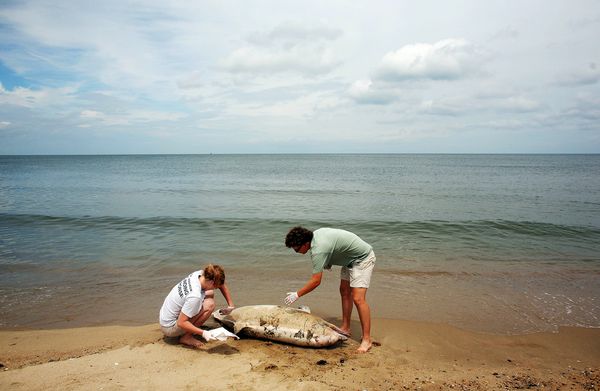Why Are Dolphins Dying on East Coast? Experts Alarmed
Trained responders examine a dead male dolphin on Ocean View Beach in Norfolk, Virginia, on August 1.
Bottlenose dolphins are washing up dead in unusually high numbers along the U.S. East Coast this summer—a "very alarming" situation that has experts scrambling to decipher the cause.
Nearly 120 corpses have washed ashore in coastal states from New York to Virginia in July and the first week of August, which is much higher than the normal number of strandings attributed to natural deaths. Virginia has had the highest mortality, with 64 animals found during that period.
One of the dolphins tested positive for morbillivirus, a measles-like, airborne virus that's often fatal in dolphins.
A morbillivirus epidemic hit East Coast bottlenose dolphins in 1987 and 1988, wiping out at least 900 animals and striking a major blow to that population of migratory dolphins.
"Because of the sheer number of animals [dying] over multiple states, people are very concerned that this might be a repeat," said Trevor Spradlin, a marine mammal biologist for the U.S. National Oceanic and Atmospheric Administration's (NOAA) National Marine Fisheries Service.
Several potential causes of death being investigated include other diseases or pathogens caused by viruses or bacteria; biotoxins caused by harmful algae blooms; pollution or chemicals, especially from concentrated spills; ship strikes; or acoustic trauma from ships or other infrastructure, he said.
"All indications show there's something serious going on."
Determining a Cause of Death
The spike follows a general trend in more dolphin strandings—or, in scientific speak, unusual mortality events—that have occurred in recent decades in the United States.
In the northern Gulf of Mexico, for instance, where there's an ongoing unusual mortality event, 1,031 dolphins and whales have washed up dead since February 2010.
The "concern is we're doing more and more to protect dolphins from harm, yet dolphin strandings are on the rise," said Matthew Huelsenbeck, a marine scientist at the nonprofit Oceana.
"No one seems to have a solid grasp as to what's going on."
But many are working to find out. For example, NOAA has a stranding network of experts who report and collect the corpses of recently deceased dolphins in an effort to determine causes of death.
A corpse is first taken into the lab for evaluation and basic triage to see if it has any visible marks that may point to the cause of its demise. Next, a tissue sample is taken and tested for viruses, which could identify a direct cause.
Then there's a longer-term investigation that involves testing blubber and organs, such as kidneys, for traces of heavy metals. Studies have shown that stranded dolphins have heavy metals in their systems.
"Dolphins are some of the most toxic animals on the planet, and it makes their immune system compromised because they're carrying so many heavy metals and toxins that accumulate in the food web," noted Huelsenbeck.
Pneumonia often occurs in dolphins with low immunity.
"Just like in humans, if you have certain afflictions affecting your immune system, you're more susceptible to pneumonia," he said.
What's more, he noted, most of the East Coast dolphin deaths have occurred in areas with heavy human footprints, like the Chesapeake Bay.
"Possibilities Wide Open"
Gregory Bossart, the Georgia Aquarium's chief veterinarian and pathologist, has been studying the impact of infectious disease and pollutants on bottlenose dolphins in Florida's Indian River Lagoon (map) for several years.
He's found that many of the lagoon's dolphins carry toxic mercury at 20 times the level permitted in human food by the U.S. government.
The dolphins there have been suffering from a host of diseases, including new papilloma and herpes viruses and fungal diseases. Some of the diseased animals share a "profoundly" suppressed immune system, he said, likely caused by the dolphins' constant exposure to environmental stressors like mercury.
Even so, Bossart cautioned that no one should jump to the morbillivirus conclusion for the current East Coast deaths before all the information is in—much more pathology work needs to be done in the lab.
"The possibilities are wide open," he said.
Ocean Canaries
Overall, the experts pointed out that the dead dolphins may be alerting us to troubles in our oceans.
Said NOAA's Spradlin, "Marine mammals are like the canary in the coal mine"—many bottlenose dolphins live on the same coasts and eat the same fish that we do.
"Our first mandate is to protect the dolphins, but the underlying bigger picture is if things are hurting these animals," he said, "[they] could also be hurting people as well."
Christine Dell'Amore
National Geographic News
Published August 7, 2013












